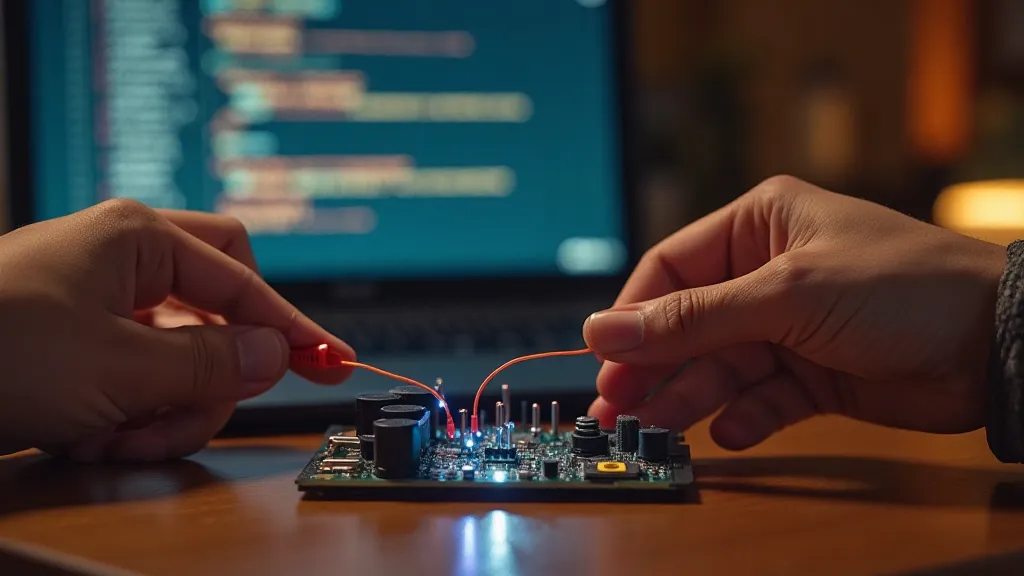Circuitry as Poetry: Translating Emotion into Electronic Response
There's a melancholic beauty to an antique accordion. The worn bellows, the ivory keys yellowed with age, the intricate carvings hinting at countless dances and heartfelt songs – it’s more than just an instrument; it's a vessel for memories, a repository of emotion. I remember visiting my grandfather’s attic as a child. Sunlight streamed through cracks in the boarded-up windows, illuminating dust motes dancing in the air, and there it sat – his accordion. He rarely played it anymore, the music trapped within its aged mechanics. But holding it, I felt a sense of connection to him, to a time I never knew, and to the silent stories woven into its construction.
That feeling – the resonance of history, the echo of emotion – is what I’m trying to capture in my electronics projects. It's the bridge between the tangible and the intangible, the logic of circuitry and the fluidity of feeling. We often think of electronics as cold, clinical, and purely functional. But what if we could imbue them with a sense of responsiveness, not just to commands, but to the subtle nuances of human emotion? This is the realm of biofeedback and affective computing, and it’s an incredibly exciting place to be.

The Foundations: Circuitry and the Human Body
At its core, the human body is an incredible bio-electrical machine. Our nervous system operates on electrochemical signals. Heart rate variability, skin conductance (measured as galvanic skin response or GSR), and brainwave activity – these are all measurable electrical phenomena that correlate with our emotional states. Traditional biofeedback techniques focus on training individuals to consciously control these physiological responses. But what if we could build circuits that *react* to them, creating a dynamic, responsive system?
Consider GSR. When we experience stress or excitement, our sweat glands become more active, increasing the electrical conductivity of our skin. A simple GSR sensor, often built using two electrodes connected to an Arduino or Raspberry Pi, can detect these changes. The beauty lies in the subtlety – it’s not just about detecting "stressed" versus "calm," but recognizing the *degree* of emotional intensity. The difference between a nervous giggle and a moment of profound anxiety can be reflected in the GSR readings. Capturing this level of precision requires an understanding of precise timekeeping, something often overlooked in introductory electronics. For those interested in building systems that rely on these fine-grained measurements, exploring techniques for precise timekeeping with Arduino can prove invaluable.
Similarly, heart rate variability (HRV) is a powerful indicator of emotional regulation. A higher HRV generally signifies greater resilience and adaptability. Optical heart rate sensors, commonly used in fitness trackers, can be interfaced with microcontrollers to extract HRV data. Analyzing these fluctuations allows us to build systems that adapt to the user’s emotional state in real-time.
Arduino and Raspberry Pi: The Emotional Architects
The accessibility of platforms like Arduino and Raspberry Pi has democratized electronics. No longer are complex circuits and programming languages exclusive to specialists. Now, anyone with a bit of curiosity and a willingness to experiment can build systems that interact with the human body. An Arduino, with its straightforward programming environment and wide range of available sensors, is ideal for simpler biofeedback projects. The Raspberry Pi, boasting more processing power and networking capabilities, opens the door to more complex systems, such as those incorporating machine learning for emotion recognition.
Imagine an art installation where the lighting changes based on the visitor’s GSR. Or a musical instrument whose tone shifts according to the player’s heart rate. The possibilities are endless. The code itself can be a form of artistic expression, a translation of raw data into a visually or aurally compelling experience. And sometimes, the most compelling experiences come from transforming what others consider waste. The spirit of creative repurposing, taking discarded electronics and breathing new life into them, is a powerful one, as exemplified by those who dedicate themselves to repurposing old electronics into artistic creations.
Beyond the Basics: Affective Computing and Machine Learning
Affective computing takes this a step further, utilizing machine learning algorithms to interpret emotional states with greater accuracy. Training a model on a dataset of GSR and heart rate data, labeled with corresponding emotional categories (e.g., joy, sadness, anger), allows the system to predict the user’s emotional state based on incoming sensor readings. This requires a more significant investment in data collection and computational resources but can yield incredibly nuanced and personalized responses.
However, it's crucial to acknowledge the ethical considerations. Building systems that interpret and react to human emotion raises questions about privacy, bias, and the potential for manipulation. Transparency and user consent are paramount. It’s our responsibility as creators to ensure that these technologies are used responsibly and ethically.

The Science of Vibration and Resonance
The pursuit of emotion-responsive circuitry often leads to explorations of natural phenomena. Just as the human body resonates with subtle shifts in emotional state, the physical world is filled with vibrational energy. Harnessing these ambient vibrations, converting them into usable power or sensory input, represents a fascinating area of research. The challenge lies in isolating meaningful signals from the constant hum of the environment – a process akin to extracting music from a crowded room. The principles of resonance and ruin—the ability to both amplify and decay energy—are key to understanding these processes.
Sensory Translation and Synesthesia
Moving beyond visual and auditory outputs, the creation of sensory experiences that cross traditional boundaries—a form of synesthesia—holds immense potential. Imagine a system that translates emotional data into tactile sensations, or even olfactory cues. The careful orchestration of these sensory mappings requires a deep understanding of how different modalities interact and influence our perception. The goal is not simply to display information, but to evoke a feeling, to create an immersive experience that engages the user on multiple levels. Exploring the possibilities of sensory output beyond visual displays showcases the potential for truly innovative and moving designs.
The Accordion's Legacy: A Metaphor for Emotional Circuitry
Returning to my grandfather’s accordion, I see a parallel between its intricate mechanics and the electronic systems we’re building today. Each key, each reed, each bellows represents a component, carefully crafted and interconnected to produce a symphony of sound. Just as a skilled accordionist draws emotion from the instrument, we can strive to build circuits that are sensitive to the subtleties of human feeling.
The antique accordion, with its history and character, carries a quiet dignity. I believe our electronic projects can embody a similar sense of purpose – not just as tools, but as extensions of ourselves, capable of expressing and responding to the full spectrum of human emotion. The challenge is not just to build functional circuits, but to imbue them with artistry, sensitivity, and a deep appreciation for the beauty of the human experience.

The process of restoring an antique accordion is much like the act of breathing new life into old technology. Both require patience, skill, and a deep respect for the history and craftsmanship involved. It’s a process of uncovering hidden beauty, of preserving a piece of the past for future generations. Similarly, when working with electronics, the ability to find value in what others discard, to transform the old into something new and meaningful, is a testament to the creativity and ingenuity of the human spirit. The care taken in reviving old electronics echoes the broader drive to design more efficient and sustainable systems, as discussed in detail by those dedicated to building automated power monitoring systems.
The spirit of experimentation and problem-solving in electronics, driven by the desire to push boundaries and explore new possibilities, is an ongoing endeavor.





